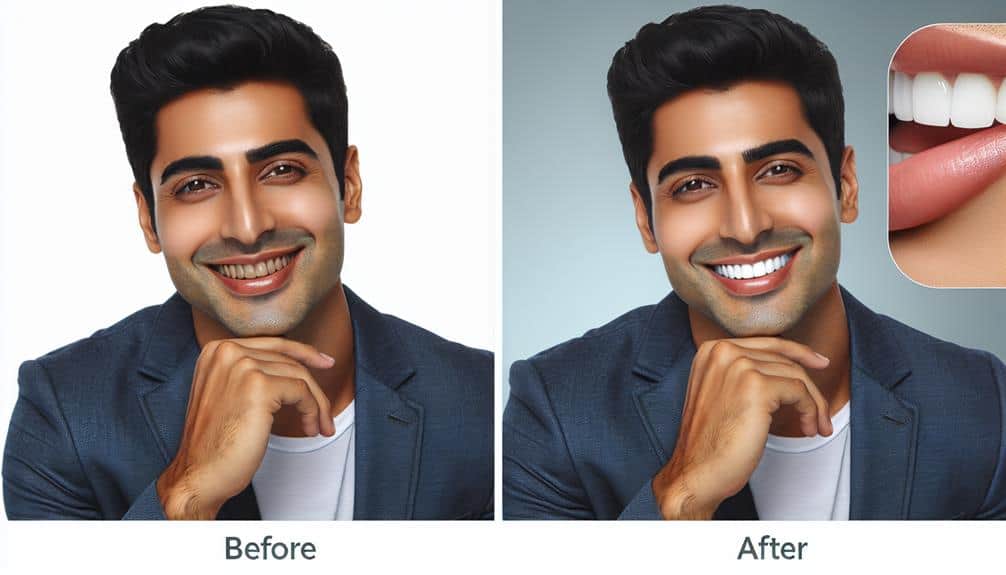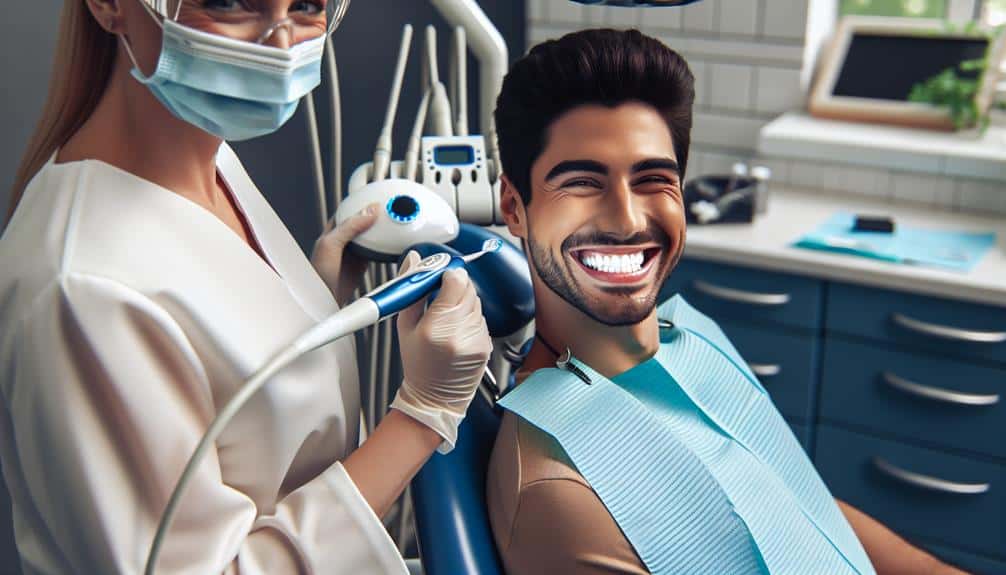When deciding between whitening strips and professional treatments, consider the following: Professional treatments can be more costly upfront but might save you money in the long run with fewer sessions. Whitening strips are budget-friendly but may require consistent use, potentially leading to higher costs if inefficacious. Professional treatments provide more long-lasting and dramatic results, although they can carry higher risks due to stronger agents. Safety-wise, whitening strips can cause gum irritation, while professional treatments are supervised by professionals. For more in-depth insights into efficacy, safety, convenience, and time commitments, explore further.
Key Points
- Professional treatments offer quicker and more dramatic whitening results.
- Whitening strips may seem budget-friendly but can result in higher overall costs.
- Safety is a concern with whitening strips due to potential gum irritation and sensitivity.
- Convenience favors whitening strips for at-home usage and flexibility in routine.
- Long-term savings can be achieved with professional treatments despite higher initial costs.
Cost Comparison
When assessing whitening treatments, it's vital to evaluate the cost differences among various options available in the market. While at first glance professional whitening treatments may seem more expensive than over-the-counter whitening strips, it's essential to examine the cost efficiency and long-term savings associated with each option.
Professional whitening treatments, although initially pricier, often provide more effective and longer-lasting results compared to whitening strips. This higher upfront cost can translate into savings over time as professional treatments may require fewer sessions to achieve the desired level of whiteness, reducing the need for frequent touch-ups.
On the other hand, whitening strips might appear like a more budget-friendly option, but they may need to be used consistently over an extended period to maintain results, leading to higher overall costs in the long run. Additionally, the effectiveness of whitening strips can vary, potentially resulting in the need for additional products to achieve the desired outcome, further impacting the cost efficiency of this option.
Effectiveness and Results
To evaluate the effectiveness and results of whitening treatments, it's essential to take into account factors such as treatment duration, whitening level achieved, and potential side effects. When comparing whitening strips to professional treatments, contemplate the following:
- Long term efficacy: Professional treatments often provide more long-lasting results compared to over-the-counter whitening strips. The professional-grade products used in clinics can penetrate deeper into the enamel, leading to more significant and longer-lasting whitening effects.
- Whitening level achieved: Professional treatments conducted by dentists can achieve a more dramatic whitening effect in a shorter amount of time compared to at-home whitening strips. The concentration of whitening agents used in professional settings is typically higher, resulting in quicker and more noticeable results.
- Potential risks: While both whitening strips and professional treatments can cause tooth sensitivity, the risks may be higher with professional treatments due to the stronger whitening agents used. It's essential to contemplate the potential risks and consult with a dentist to determine the most suitable option for your individual needs.
Safety Considerations
Taking into account the safety aspects of whitening treatments is vital to guaranteeing a positive experience and optimal outcomes for your dental health. When considering different whitening options, it's essential to be aware of potential health risks associated with these treatments.
Whitening strips, if not used correctly, can lead to gum irritation and tooth sensitivity. Professional treatments, on the other hand, are usually supervised by trained professionals, minimizing the risk of adverse effects.
Additionally, product quality plays a significant role in safety. Lower-quality whitening products may contain harmful ingredients that can damage your teeth and gums. It's important to research and choose reputable brands or professional services to ensure the security of your whitening treatment.
Convenience and Ease of Use
For individuals seeking whitening treatments, considering the convenience and ease of use is essential in determining the most suitable option for achieving a brighter smile. When comparing whitening strips to professional treatments, these key points will help you make an informed decision:
- Application process: Whitening strips typically involve a straightforward application process that can be easily done at home. On the other hand, professional treatments may require multiple visits to a dental office for application by a trained professional, which can be time-consuming.
- On the go usage: Whitening strips offer the convenience of on-the-go usage, allowing you to whiten your teeth while performing other activities. Professional treatments, however, may limit your mobility during the application process, as they often require you to remain stationary for a certain period.
- Effectiveness and convenience balance: While professional treatments may deliver faster and more noticeable results, the convenience of whitening strips allows for more flexibility in your daily routine without compromising on effectiveness.
Considering these factors can help you choose the whitening treatment that best aligns with your lifestyle and preferences.
Duration and Time Commitment
Considering the duration and time commitment required for different whitening treatments is crucial when deciding on the most suitable option for achieving a brighter smile. Professional whitening treatments typically offer quicker results compared to whitening strips. In-office procedures often require one to two visits lasting around 30 to 90 minutes each, with significant whitening effects visible immediately or within a few days. On the other hand, whitening strips need to be worn daily for about 30 minutes to an hour over a span of one to two weeks to achieve noticeable results.
When evaluating time effectiveness, professional treatments stand out for their ability to deliver rapid outcomes within a short duration. The concentrated bleaching agents used in these treatments can provide more impactful results in a shorter timeframe compared to over-the-counter options like whitening strips. If you prioritize quick and efficient whitening, investing in professional treatments might be the best choice due to their shorter treatment duration and faster visible results.
Frequently Asked Questions
Are There Any Specific Dietary Restrictions or Habits That Should Be Followed During or After Using Whitening Strips or Professional Treatments?
During whitening treatments, avoid foods and drinks that stain teeth. Rinse your mouth after consumption to help maintain results. To manage sensitivity, use desensitizing toothpaste and follow post-treatment instructions. Establish good oral hygiene habits for lasting effects.
Can Whitening Strips or Professional Treatments Cause Sensitivity in Teeth, and if So, How Can It Be Managed?
To manage sensitivity from whitening treatments, try using toothpaste for sensitive teeth, avoid hot or cold foods, and limit acidic beverages. Prioritize dental hygiene, consider desensitizing products, and consult your dentist for personalized advice on preventative measures.
Are There Any Long-Term Effects or Risks Associated With Using Whitening Strips or Professional Treatments Over Time?
Over time, both whitening strips and professional treatments can lead to long-term risks such as enamel damage and gum irritation. It's essential to monitor usage frequency and consult with a dentist to mitigate potential adverse effects.
Will Whitening Strips or Professional Treatments Affect Dental Restorations Like Fillings, Crowns, or Veneers?
When contemplating dental restorations such as fillings, crowns, or veneers, it is crucial to grasp how whitening strips or professional treatments may affect them. Seek guidance from your dentist to confirm restoration compatibility and explore the effectiveness comparison, safety concerns, and cost analysis.
Are There Any Age Restrictions or Special Considerations for Using Whitening Strips or Professional Treatments on Children or Teenagers?
When considering safety concerns for teenagers' teeth, it's essential to acknowledge any age restrictions and seek parental consent before using whitening strips or professional treatments. Always prioritize the well-being of young individuals' dental health.
Conclusion
To summarize, when comparing whitening strips to professional treatments, it's important to take into account factors such as cost, effectiveness, safety, convenience, duration, and time commitment.
Did you know that professional treatments can whiten teeth up to 8 shades in just one session, while whitening strips typically only whiten teeth up to 3 shades over multiple uses? This statistic highlights the significant difference in results between the two options.
Make an informed decision based on your priorities and goals for teeth whitening.



